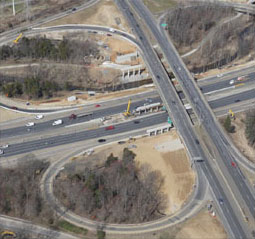Public-Private Partnerships (P3s) are long-term contractual agreements between a public agency and a private entity to design, build, finance, operate and maintain (DBFOM) an infrastructure project. A P3 involves the private sector taking on additional project risks. Generally, the cost of a P3 for transportation projects ranges from a few hundred million dollars to more than a billion dollars.
Under traditional procurement, private contractors construct projects based on a public design with public financing and turn them over to the public sector upon completion for operations and maintenance. More recently, Design-Build procurement - under which the private sector is responsible for designing and building projects for a fixed price - has been increasing. Under P3 models, the private sector may also participate in design, finance, operations, and maintenance.

P3s feature different ways to repay private investors. In some cases, private investors can receive compensation through obtaining the right to collect tolls on a facility. In that case, the concessionaire is accepting "traffic and revenue risk" - the risk that the facility's traffic will not be sufficient to provide adequate revenue. Another model involves availability payments, in which the concessionaire receives a payment from the public sponsor based on the availability of a facility at a specified performance level. In this case, the concessionaire accepts operational and appropriation risks - the risks that (a) the concessionaire does not meet the contractual performance targets; and (b) the risk that the public sector sponsor may not receive sufficient appropriation to make the required payment.
The chart on side 2 presents a sampling of payment models for P3s; States can create other compensation structures that provide incentives to achieve their goals.
P3s can provide access to private capital, reduce costs borne by transportation agencies, accelerate project delivery, shift project risk, spur innovation, and provide for more efficient management. Long-term concessions can improve asset management - the party that constructs the project is responsible for long-term operation. This creates incentives to build a higher quality facility that is easier to maintain.
However, in spite of the potential advantages of P3s, their implementation can suffer from several disadvantages and impediments. For example, they require considerable administrative cost and time to develop, analyze, procure, and monitor. They may not be the most cost-effective or appropriate procurement model if the public sector can deliver better value with traditional or other alternative short-term contracting methods such as Construction Manager/ General Contractor (CM/GC), Design-Build (DB), Design-Build-Finance (DBF) or Progressive Design-Build (PDB). FHWA’s Contracting Alternatives Suitability Evaluator (CASE) webtool assists public sponsors in selecting the most appropriate delivery method for a specific project from among the gamut of traditional and alternative contracting methods.P3s are undertaken for a variety of purposes. In some cases, the purpose is to use existing assets that charge user fees to generate upfront funds for transportation by leasing the asset to a concessionaire (a.k.a. asset monetization). In other cases, P3s are used to develop greenfield (i.e., new construction) projects or to rehabilitate and expand existing facilities.
For further Information: See FHWA's Public-Private Partnership Concessions for Highway Projects: A Primer, available at: https://www.fhwa.dot.gov/ipd/p3/
| P3 Structure | Design Risk | Const. Risk | Financial Risk | O&M Risk | Traffic Risk and Revenue Risk |
|---|---|---|---|---|---|
| Traditional Design-Bid-Build | X | ||||
| Design-Build | X | X | |||
| Design, Build, Finance, Operate, and Maintain | X | X | X | X | Yes, if traffic-based payment (i.e., toll or shadow-toll payment structure) |
Note. Const. = Construction; O&M = Operations and Maintenance.
| Model | Description |
|---|---|
| Toll Concession | Private partner takes on project in exchange for receiving tolls. Public sector usually limits rate of toll increase in some way. |
| Shadow Toll Concession | Private partner receives payment for each vehicle that uses the facility. Sometimes payment is adjusted based on performance measures related to safety or congestion, or pre-established floors and ceilings. |
| Availability Payment | Private partner receives payment based on availability of the facility at a specified performance level, with payment deductions if performance is not at the specified level. |
The FHWA Center for Innovative Finance Support is a one-stop clearinghouse for expertise, guidance, research, decision tools, and publications on highway program delivery innovations. Our website, workshops, and myriad resources support transportation professionals in the use of innovative approaches for delivery of highway projects.
The FHWA Center for Innovative Finance Support's P3 program focuses on resources and capacity building for consideration and use of design-build-finance-operate-maintain (DBFOM) concessions funded through tolls or availability payments.
The FHWA Center for Innovative Finance Support's Alternative Project Delivery program provides information on contractual arrangements that allow for greater private participation in infrastructure development by transferring risk and responsibility from public project sponsors to private sector engineers, contractors and investors.
The FHWA Center for Innovative Finance Support's Project Finance program focuses on alternative financing, including State Infrastructure Banks (SIBs), Grant Anticipation Revenue Vehicles (GARVEEs), and Private Activity Bonds (PABs).
The FHWA Center for Innovative Finance Support's Federal Tolling and Pricing program focuses on the use of tolling and other road user charges as a revenue source to fund highway improvements, and the use of variably-priced tolls as a tool to manage congestion.
The FHWA Center for Innovative Finance Support's Value Capture program explores strategies for tapping into the added value that transportation improvements bring to nearby properties as a means to provide new funding for surface transportation improvements.